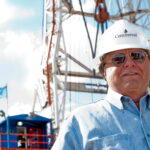Will they gather enough signatures this time around?
The 2018 Colorado ballot initiative that would change state law to require 2,500-foot setbacks from occupied structures, playgrounds and water sources for new oil and gas development projects is in the signature gathering phase. It is Initiative #97.
The groups behind the newest setback initiative have just 68 more days to collect 100,000+ signatures needed to successfully land a new setback statute for new oil and gas development projects on the 2018 Colorado ballot.
By Aug. 6, Colorado Rising, the campaign group’s name, must turn in enough signatures to the Colorado Secretary of State for the verification process to result in 98,492 valid signatures of voters requesting the law be changed.
In Colorado, the number of signatures required to qualify an initiated state statute for the ballot is equal to 5 percent of the total number of votes cast for the office of Colorado secretary of state in the preceding general election.
Ballotpedia reports that:
- The signature must be of a registered voter, as established by comparing the name to that state’s list of registered voters.
- The signature on the petition must match the signature on the voter registration card filed when that voter registered to vote.
- The signature must not be a duplicate signature. This occurs when a voter signs the same petition more than once. If this happens, in some states, one signature counts and the other(s) don’t. In other states, if a voter signs more than once, none of his or her signatures count.
The ballot title for Initiative #97 reads as follows:
“Shall there be a change to the Colorado Revised Statutes concerning a statewide minimum distance requirement for new oil and gas development, and, in connection therewith, changing existing distance requirements to require that any new oil and gas development be located at least 2,500 feet from any structure intended for human occupancy and any other area designated by the measure, the state, or a local government and authorizing the state or a local government to increase the minimum distance requirement?”
Here is how the proposed revised statute reads:
Be it Enacted by the People of the State of Colorado:
SECTION 1. In Colorado Revised Statutes, add 34-60-131 as follows:
34-60-131. Mitigation of adverse oil and gas impacts to health and safety — buffer zones — legislative declaration – definitions.
(1) THE PEOPLE Of THE STATE Of COLORADO FiND AND DECLARE THAT:
(a) PROxIMITY TO OIL AND GAS DEVELOPMENT, INCLUDING THE USE Of HYDRAULIC FRACTURING, HAS DETRIMENTAL IMPACTS ON PUBLIC HEALTH, SAFETY, WELfARE, AND THE ENVIRONMENT;
(b) SUCH IMPACTS ARE REDUCED BY LOCATING OIL AND GAS OPERATIONS AWAY FROM OCCUPIED STRUCTURES AND VULNERABLE AREAS; AND
(c) To PRESERVE PUBLIC HEALTH, SAFETY, WELFARE, AND THE ENVIRONMENT, THE PEOPLE DESIRE TO ESTABLISH A BUFFER ZONE REQUIRING ALL NEW OIL AND GAS DEVELOPMENT IN THE STATE OF COLORADO TO BE LOCATED AN INCREASED DISTANCE AWAY FROM OCCUPIED STRUCTURES, INCLUDING HOMES, SCHOOLS AND HOSPITALS, AS WELL AS VULNERABLE AREAS.
(2) AS USED IN THIS SECTION, UNLESS THE CONTEXT OTHERWISE REQUIRES:
(a) “OCCUPIED STRUCTURE” MEANS ANY BUILDING OR STRUCTURE THAT REQUIRES A CERTIFICATE OF OCCUPANCY OR BUILDING OR STRUCTURE INTENDED FOR HUMAN OCCUPANCY, INCLUDING HOMES, SCHOOLS, AND HOSPITALS.
(b) “OIL AND GAS DEVELOPMENT” MEANS EXPLORATION FOR, AND DRILLING, PRODUCTION, AND PROCESSING OF, OIL, GAS, OR OTHER GASEOUS AND LIQUID HYDROCARBONS, AND FLOWL1NES AND THE TREATMENT OF WASTE ASSOCIATED WITH SUCH EXPLORATION, DRILLING, PRODUCTION AND PROCESSING. “OIL AND GAS DEVELOPMENT” INCLUDES HYDRAULIC FRACTURING.
(c) “VULNERABLE AREAS” MEANS PLAYGROUNDS, PERMANENT SPORTS FIELDS, AMPHITHEATERS, PUBLIC PARKS, PUBLIC OPEN SPACE, PUBLIC AND COMMUNITY DRINKiNG WATER SOURCES, IRRIGATION CANALS, RESERVOIRS, LAKES, RIVERS, PERENNIAL OR INTERMITTENT STREAMS, AND CREEKS, AND ANY ADDITIONAL VULNERABLE AREAS DESIGNATED BY THE STATE OR A LOCAL GOVERNMENT.
(d) “LOCAL GOVERNMENT” MEANS ANY STATUTORY OR HOME RULE COUNTY, CITY AND COUNTY, CITY, OR TOWN LOCATED IN THE STATE OF COLORADO.
(3) THE PEOPLE OF THE STATE OF COLORADO HEREBY ESTABLISH THAT ALL NEW OIL AND GAS DEVELOPMENT NOT ON FEDERAL LAND MUST BE LOCATED AT LEAST TWO THOUSAND FIVE HUNDRED FEET FROM AN OCCUPIED STRUCTURE OR VULNERABLE AREA. FOR PURPOSES OF THIS SECTION, THE REENTRY OF AN OIL OR GAS WELL PREVIOUSLY PLUGGED OR ABANDONED IS CONSIDERED NEW OIL AND GAS DEVELOPMENT.
(4) THE STATE OR A LOCAL GOVERNMENT MAY REQUIRE THAT NEW OIL AND GAS DEVELOPMENT BE LOCATED A LARGER DISTANCE AWAY FROM OCCUPIED STRUCTURES OR VULNERABLE AREAS THAN REQUIRED BY SUBSECTION (3) OF THIS SECTION. IN THE EVENT THAT TWO OR MORE LOCAL GOVERNMENTS WITH JURISDICTION OVER THE SAME GEOGRAPHIC AREA ESTABLISH DIFFERENT BUFFER ZONE DISTANCES, THE LARGER BUFFER ZONE GOVERNS.
(5) THIS SECTION TAKES EFFECT UPON OFFICIAL DECLARATION OF THE GOVERNOR AND IS SELF-EXECUTING.
(6) THIS SECTION APPLIES TO OIL AND GAS DEVELOPMENT PERMITTED ON OR AFTER THE EFFECTIVE DATE.
“Our supporters are in the community collecting signatures,” according to Colorado Rising.
The groups have until August 6th to collect approximately 100k signatures in order to qualify the initiative to be placed for the November 2018 ballot. Most sources believe the number will have to be closer to 120,000+ to yield the 98,492 valid signatures required by the secretary of state.
Who is behind the initiative?
Colorado Rising is the campaign name that is also the public website face of the initiative. According to the group’s website, Colorado Rising formed “to protect our communities from the dangers of fracking.”
“Currently, fracking operations are allowed to take place just 500’ from a home and 1,000’ from a school building (and right by school playgrounds). The industry has shown blatant disregard for public health and safety, and the current state regulatory body – the Colorado Oil and Gas Conservation Commission (COGCC) – has not provided responsible protective regulatory oversight to prevent inappropriate siting of toxic fracking operations adjacent to homes, schools and water sources,” the Colorado Rising website says.
There are international climate action groups behind the Colorado Rising initiative including 350.org and the Sierra Club, both of which are large, well-funded and long-established global anti-fossil fuel organizations. In all, the website lists 68 supporting groups in Colorado. That’s a lot of volunteer power, access to deep pockets and a loud awaiting swarm of social media influence at the initiative’s fingertips.
Fund-raising
In a fund-raising email sent today via professional campaign consultancy ngpvan.com, 350.org said: “The fossil fuel industry can far outspend us, but they cannot beat us in people power. …As World Environment Day approaches on June 5th, we’re launching our 2018 People Power Money Shower, a fundraising event running through June 5th to advance local climate justice efforts. What will your donation fund?
- Campaigns to promote divestment from fossil fuels for cities and Public Employees Retirement Association Funds
- Stopping fracking in Colorado through a statewide ballot initiative and mobilizations to pressure candidates and leaders for policy change
- Making climate change a top priority in the 2018 elections for candidates through the People’s Climate Justice Platform
- And much more!
Will enough Colorado voters sign the petition?
Ahead of the previous statewide election in 2016, a coalition of some of the same groups attempted to get setback and local control initiatives on the 2016 ballot. The groups had proposed a ballot initiative to amend the state’s constitution to require a 2,500-foot mandatory setback for oil and gas development.
The move would have reduced the surface area available for drilling by 90%, according to a study from the Colorado Oil and Gas Conservation Commission (COGCC) in 2016. That could have led to the state losing $14.5 billion and 104,000 jobs, the University of Colorado reported. But the initiative +failed to generate the required 98,492 number of valid signatures set by Colorado law.
In 2018, however, the anti-oil-and-gas groups appear to be better organized, better funded and backed by a larger number of high-powered climate allies. And 2018’s initiative #97 is proposing a change to state statute, not a proposed amendment to the constitution.
Younger voters, Millennials more likely to sign petitions for activists
But the state demographics in Colorado are moving younger. Almost 40% of the Colorado population is between age 20 and 44. Colorado is one of the top draws for college-graduated Millennials who are being lured to the state by a booming job market and a casual, ‘feel free to be yourself’ lifestyle along the Colorado Front Range.
A growing voter base of twenty- and thirty-somethings are likely to be more willing to be approached by young activists at any number of Colorado’s outdoor entertainment venues for the months in advance of the Aug. 6 deadline. If the young voters bring strong climate change beliefs back from college, they may be eager to sign the 2,500-foot setback petition in the name of health, safety and climate justice. If their numbers are high enough, things could turn out differently this time around.







